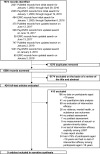Mental Health, Drug, and Violence Interventions for Sexual/Gender Minorities: A Systematic Review
- PMID: 31427462
- PMCID: PMC6855817
- DOI: 10.1542/peds.2018-3367
Mental Health, Drug, and Violence Interventions for Sexual/Gender Minorities: A Systematic Review
Abstract
Context: Compared with cisgender (nontransgender), heterosexual youth, sexual and gender minority youth (SGMY) experience great inequities in substance use, mental health problems, and violence victimization, thereby making them a priority population for interventions.
Objective: To systematically review interventions and their effectiveness in preventing or reducing substance use, mental health problems, and violence victimization among SGMY.
Data sources: PubMed, PsycINFO, and Education Resources Information Center.
Study selection: Selected studies were published from January 2000 to 2019, included randomized and nonrandomized designs with pretest and posttest data, and assessed substance use, mental health problems, or violence victimization outcomes among SGMY.
Data extraction: Data extracted were intervention descriptions, sample details, measurements, results, and methodologic rigor.
Results: With this review, we identified 9 interventions for mental health, 2 for substance use, and 1 for violence victimization. One SGMY-inclusive intervention examined coordinated mental health services. Five sexual minority-specific interventions included multiple state-level policy interventions, a therapist-administered family-based intervention, a computer-based intervention, and an online intervention. Three gender minority-specific interventions included transition-related gender-affirming care interventions. All interventions improved mental health outcomes, 2 reduced substance use, and 1 reduced bullying victimization. One study had strong methodologic quality, but the remaining studies' results must be interpreted cautiously because of suboptimal methodologic quality.
Limitations: There exists a small collection of diverse interventions for reducing substance use, mental health problems, and violence victimization among SGMY.
Conclusions: The dearth of interventions identified in this review is likely insufficient to mitigate the substantial inequities in substance use, mental health problems, and violence among SGMY.
Copyright © 2019 by the American Academy of Pediatrics.
Conflict of interest statement
POTENTIAL CONFLICT OF INTEREST: The authors have indicated they have no potential conflicts of interest to disclose.
Figures
Comment in
-
Urgent Need for Research to Achieve Health Equity for Sexual and Gender Minority Youth.Pediatrics. 2019 Sep;144(3):e20192133. doi: 10.1542/peds.2019-2133. Epub 2019 Aug 19. Pediatrics. 2019. PMID: 31427461 Free PMC article. No abstract available.
References
-
- Institute of Medicine The Health of Lesbian, Gay, Bisexual, and Transgender People: Building a Foundation for Better Understanding. Washington, DC: The National Academies Press; 2011 - PubMed


